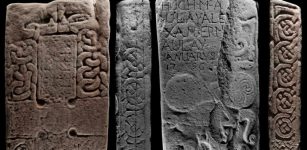Vesta And Her Six Vestal Virgins – Highly Venerated Goddess Of Hearth And Family
A. Sutherland - AncientPages.com - In ancient Roman beliefs, Vesta (the equivalent of the Greeks' Hestia) was the goddess of fire, home, and family.
She was an abstract goddess of the hearth, chastity, and ritual bonfires.
The goddess was rarely depicted in human form, and generally, no myths are associated with her. However, Vesta is one of the most important Roman divinities and probably one of the oldest European deities. She was one of the daughters of Saturn and Ops, a goddess of fertility and earth.
No temple or household began with their ceremonies until Vesta's fire was lit. The cult of Vesta, however, was religious worship that lay deep in our Indo-European past and was grown privately by individual families.
Also, the veneration of fire is an old tradition. Fire has been essential in human life since the dawn of history. The deification of fire is known from various Indo-European cultures. One of the most important deities in the Slavic pantheon was Svarog (Swarog), the god of celestial fire and the guardian of the Slavic home fire and the sacrificial fire. In Vedic India, people worshiped the fire-god Agni (which means: 'fire'), and the ancient Iranian Zoroastrians were famous fire-worshippers. Their concept of holy fire was Atar (fire god).
Officially, Vesta was represented by the sacred, eternal fire in her temple in the Roman Forum ('Forum Romanum'), considered the heart of ancient Rome.
Despite that worship of Vesta, and several other gods, had its roots in the Roman home, with time, it developed into an established cult during the reign of either Romulus or Numa Pompilius.
The latter is believed to have introduced her worship in Rome and constructed the temple in Vesta's honor, initially located on the slope of Palatine Hill. It was not an ordinary temple where gatherings could occur, as in other Roman temples.
 A vestal virgin. Gravy av Frederick Leighton, circa 1890. Public Domain
A vestal virgin. Gravy av Frederick Leighton, circa 1890. Public Domain
An eternal fire, representing Vesta, burned in the temple, and it ceased to exist in 394 AD at the order of the Christian Emperor Theodosius the Great, a Roman Emperor from 379 to 395. Theodosius (who also banned the pagan rituals of the Olympics in ancient Greece) dissolved the Order of the Vestal Virgins in Rome.
Vestals And Their Life After Thirty-Year-Long Service
Her priestesses - Vestals - were the virgins who kept and cared for the sacred fire that symbolized the existence of Rome (the 'eternal city').
According to tradition, six chosen vestals came to serve the goddess. These girls (seven to 10 years old and from good families) had to take a vow of chastity. If the vow was broken and the Vestal was found guilty, she was punished by being walled up in the Campus Sceleris ('Field of Wickedness') and left for her death.
The priestesses were freed of the usual social obligations to marry and bear children. Instead, they devoted themselves to the study and correcting state rituals that were off-limits to the male colleges of priests.
 Vestal virgin hanging an ivy wreath during Vestalia Festival. Carl Friedrich Deckler (1838–1918). Public Domain
Vestal virgin hanging an ivy wreath during Vestalia Festival. Carl Friedrich Deckler (1838–1918). Public Domain
The Vestals played an essential role in ancient Rome's ceremonial life. Besides guarding Vesta's fire, the Vestals often attended festivals, and their duties included making the so-called "salted flour" (mola salsa), a mixture sprinkled over the sacrificial animals. The Vestals served in the temple for thirty years before being replaced by new ones.
After thirty years, the Vestal could give up the priesthood, return to ordinary life and even get married. Few of them, however, used this right. Instead, they preferred to serve the goddess until their death.
Vestals could, with their own hands, without a guarantor, manage their affairs, which for the most part, were not allowed to other Roman women.
The Vestals in the service enjoyed great privileges and honors as a reward for their long and dedicated service. The consul himself at the meeting gave way to the vestals.
 Statues of the Vestal Virgins - in front of the Atrium Vestae. Image Credit: Carole Raddato - CC BY-SA 2.0
Statues of the Vestal Virgins - in front of the Atrium Vestae. Image Credit: Carole Raddato - CC BY-SA 2.0
Vestalia Festival That Honored The Goddess And Her Priestesses
Vesta was highly respected as the one who watched over the hearth, which provided light and warmth, nourishment, and protection to the family. In this way, she was a guardian of the Roman people, and as much as they divinized the hearth, they also honored Vesta's existence by organizing the Vestalia. It was one of the most celebrated Roman holidays from the 7th to the 15th of June each year.
During this holiday, married women made offerings in the form of food in Vesta's temple. It was also a festival of bakers; Vesta's priestesses baked special bread made of salted flour, and the mills were decorated with wreaths and flowers.
Written by – A. Sutherland - AncientPages.com Senior Staff Writer
Updated on March 30, 2024
Copyright © AncientPages.com All rights reserved. This material may not be published, broadcast, rewritten or redistributed in whole or part without the express written permission of AncientPages.com
Expand for referencesReferences:
Benjamin W. Fortson, IV, Indo-European Language, and Culture: An Introduction
Mary Beard M. North J. Religions of Rome: Volume 1
More From Ancient Pages
-
 Tetzacualco – Mesoamerican Mini Model Of The Universe Discovered Underwater
Archaeology | Jan 4, 2018
Tetzacualco – Mesoamerican Mini Model Of The Universe Discovered Underwater
Archaeology | Jan 4, 2018 -
 Rare Lost Pictish Stone With Strange Mythical Beasts Goes On Display For The First Time
Artifacts | Dec 12, 2020
Rare Lost Pictish Stone With Strange Mythical Beasts Goes On Display For The First Time
Artifacts | Dec 12, 2020 -
 Five Witchcraft Myths Debunked By An Expert
Featured Stories | Oct 27, 2023
Five Witchcraft Myths Debunked By An Expert
Featured Stories | Oct 27, 2023 -
 New Clues To Behavior Of Neanderthal Hunting Parties
Archaeology | Mar 27, 2023
New Clues To Behavior Of Neanderthal Hunting Parties
Archaeology | Mar 27, 2023 -
 Hina Matsuri Festival – Sending Dolls In Boats Into The Ocean To Celebrate Girl’s Day In Japan – Ancient Shinto Tradition
Ancient Traditions And Customs | Apr 29, 2019
Hina Matsuri Festival – Sending Dolls In Boats Into The Ocean To Celebrate Girl’s Day In Japan – Ancient Shinto Tradition
Ancient Traditions And Customs | Apr 29, 2019 -
 Ancient Mystery Of Acra Citadel – Solved
Archaeology | Nov 3, 2015
Ancient Mystery Of Acra Citadel – Solved
Archaeology | Nov 3, 2015 -
 DNA Unravels Mysteries Of The Crannogs, Ancient Artificial Islands Older Than Stonehenge
Archaeology | Oct 10, 2022
DNA Unravels Mysteries Of The Crannogs, Ancient Artificial Islands Older Than Stonehenge
Archaeology | Oct 10, 2022 -
 Tuonela – The Land Of The Dead In Beliefs Of Ancient Finnish People
Featured Stories | Nov 9, 2021
Tuonela – The Land Of The Dead In Beliefs Of Ancient Finnish People
Featured Stories | Nov 9, 2021 -
 Ancient Tomb Chamber Of Parthian Warrior Was Accidentally Unearthed In Iran
Archaeology | Apr 30, 2020
Ancient Tomb Chamber Of Parthian Warrior Was Accidentally Unearthed In Iran
Archaeology | Apr 30, 2020 -
 Previously Unknown 2,000-Year-Old Celtiberian City Discovered- Has The Lost City Of Titiakos Been Found?
Archaeology | Jul 18, 2023
Previously Unknown 2,000-Year-Old Celtiberian City Discovered- Has The Lost City Of Titiakos Been Found?
Archaeology | Jul 18, 2023 -
 Mysterious Ichthys – Ancient Secret Christian Symbol With A Deep Meaning
Ancient Symbols | Mar 6, 2018
Mysterious Ichthys – Ancient Secret Christian Symbol With A Deep Meaning
Ancient Symbols | Mar 6, 2018 -
 Ancient Ruins Of Quilmes: Largest Pre-Colombian Settlement In Argentina
Featured Stories | Mar 28, 2019
Ancient Ruins Of Quilmes: Largest Pre-Colombian Settlement In Argentina
Featured Stories | Mar 28, 2019 -
 Secret Group Searching For Ancient Giants’ Skeletons In NZ Worries Archaeologists
Archaeology | Mar 19, 2020
Secret Group Searching For Ancient Giants’ Skeletons In NZ Worries Archaeologists
Archaeology | Mar 19, 2020 -
 Centuries-Old Hunt For Vanished Treasures
Artifacts | Nov 8, 2018
Centuries-Old Hunt For Vanished Treasures
Artifacts | Nov 8, 2018 -
 Unknown Highly Advanced Civilization Created Malta’s Cart Ruts With Sophisticated Machinery
Ancient Technology | Apr 26, 2014
Unknown Highly Advanced Civilization Created Malta’s Cart Ruts With Sophisticated Machinery
Ancient Technology | Apr 26, 2014 -
 Three Bronze Age Chariots, Shields, Daggers And Decorated Coffins Unearthed In Northern India
Archaeology | Jun 7, 2018
Three Bronze Age Chariots, Shields, Daggers And Decorated Coffins Unearthed In Northern India
Archaeology | Jun 7, 2018 -
 The Word Freelancer Originates From Medieval Mercenary Knights
Ancient History Facts | Feb 25, 2016
The Word Freelancer Originates From Medieval Mercenary Knights
Ancient History Facts | Feb 25, 2016 -
 Eclipse Was A Bad Omen, A Sign Of Gloom And Doom In Ancient Peoples’ Beliefs
Featured Stories | Sep 25, 2015
Eclipse Was A Bad Omen, A Sign Of Gloom And Doom In Ancient Peoples’ Beliefs
Featured Stories | Sep 25, 2015 -
 Where Is The Tomb Of Imhotep, Pharaoh Djoser’s Magician Hidden?
Featured Stories | Jun 8, 2021
Where Is The Tomb Of Imhotep, Pharaoh Djoser’s Magician Hidden?
Featured Stories | Jun 8, 2021 -
 On This Day In History: Father Of Nation Mahatma Gandhi Was Born – On Oct 2, 1869
News | Oct 2, 2016
On This Day In History: Father Of Nation Mahatma Gandhi Was Born – On Oct 2, 1869
News | Oct 2, 2016

